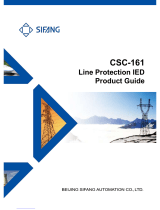
10.4.15 Under impedance protection for Generator ZGVPDIS..............................................................134
10.4.15.1 Verifying the settings...................................................................................................................134
10.4.15.2 Completing the test......................................................................................................................137
10.5 Current protection................................................................................................................................137
10.5.1 Instantaneous phase overcurrent protection 3-phase output PHPIOC (50)........................137
10.5.1.1 Measuring the trip limit of set values....................................................................................... 138
10.5.1.2 Completing the test..................................................................................................................... 138
10.5.2 Four step phase overcurrent protection 3-phase output OC4PTOC (51_67).......................138
10.5.2.1 Verifying the settings...................................................................................................................138
10.5.2.2 Completing the test..................................................................................................................... 139
10.5.3 Instantaneous residual overcurrent protection EFPIOC (50N)...............................................139
10.5.3.1 Measuring the trip limit of set values.......................................................................................140
10.5.3.2 Completing the test..................................................................................................................... 140
10.5.4 Four step residual overcurrent protection, (Zero sequence or negative sequence
directionality) EF4PTOC (51N/67N)............................................................................................. 140
10.5.4.1 Four step directional ground fault protection....................................................................... 140
10.5.4.2 Four step non-directional ground fault protection................................................................141
10.5.4.3 Completing the test......................................................................................................................141
10.5.5 Four step negative sequence overcurrent protection NS4PTOC (46I2)................................141
10.5.5.1 Completing the test..................................................................................................................... 142
10.5.6 Sensitive directional residual overcurrent and power protection SDEPSDE (67N)............ 142
10.5.6.1 Measuring the trip and time limit for set values.................................................................... 142
10.5.6.2 Completing the test..................................................................................................................... 147
10.5.7 Thermal overload protection, one time constant, Fahrenheit/Celsius LFPTTR/
LCPTTR (26)....................................................................................................................................... 148
10.5.7.1 Measuring the trip and time limit of set values......................................................................148
10.5.7.2 Completing the test..................................................................................................................... 148
10.5.8 Thermal overload protection, two time constants TRPTTR (49)............................................149
10.5.8.1 Checking trip and reset values...................................................................................................149
10.5.8.2 Completing the test..................................................................................................................... 149
10.5.9 Breaker failure protection, phase segregated activation and output CCRBRF (50BF)..... 150
10.5.9.1 Checking the phase current trip value,
Pickup_PH
................................................................ 150
10.5.9.2 Checking the residual (ground fault) current trip value
Pickup_N
set below
Pickup_PH
....................................................................................................................150
10.5.9.3 Checking the re-trip and back-up times.................................................................................. 150
10.5.9.4 Verifying the re-trip mode........................................................................................................... 151
10.5.9.5 Verifying the back-up trip mode................................................................................................ 151
10.5.9.6 Verifying instantaneous back-up trip at CB faulty condition.............................................. 152
10.5.9.7 Verifying the case
RetripMode
=
Contact
................................................................................ 153
10.5.9.8 Verifying the function mode
Current&Contact
.......................................................................153
10.5.9.9 Completing the test..................................................................................................................... 154
10.5.10 Pole discrepancy protection CCPDSC (52PD).............................................................................154
10.5.10.1 Verifying the settings...................................................................................................................154
Table of contents
5
Commissioning manual























